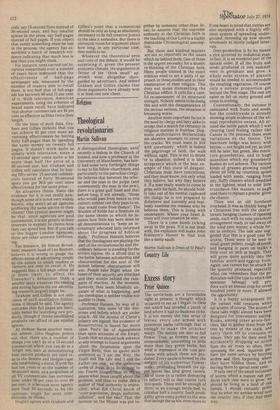Country Life
Excess story
Peter Quince
The nettle-beds are a formidable sight at present: a thought which occurred to me as I began to clear one which had invaded a patch of land where it had no business to be. It is not merely the vast array of leaves, every one armed with poisonous barbs (although that is enough to make the attacker wary). The nettles are also in full flower. True, as flowers they are unremarkable, amounting to little more than tiny green blobs, but what is impressive is the vast pro; fusion with which these are produced. Every nettle is bowed by the weight of its numerous flowerstalks, protruding beneath the upper leaves like limp green tassels. All of these (it is rather dismaying to reflect) will in due course turn into seeds. There will be enough of them, in an average nettle-bed, to colonise half a county. Such prodigality gives extra power to the arm that swings the sickle, even more so
if one bears in mind that nettles are also equipped with a highly efficient system of spreading underground, throwing up new shoots wholesale at nicely-judged intervals.
Over-production is by no means a vice invented by industrial man, in‘fact. It is an essential part of the natural order. If all the fruits and seeds produced in one summer were to germinate and grow, a whole solar system of planets would be needed to accommodate the resulting vegetation. Of course only a minute proportion get beyond the first stage. The rest are eaten or fall on stony ground and come to nothing.
Conventionally, the autumn is associated with fruits and seeds, but the countryside is already showing ample evidence of the annual reproductive excess. All around the nettle patch which I was clearing (and feeling rather like Canute in the process) there were variations on the theme. The hawthorn hedge was heavy with berries — not bright red yet, as they will be later, but green, like miniature gooseberries, and in huge quantities which my gooseberry bushes do not achieve. The various kinds of grasses growing round about all help up countless spikes loaded with seeds, ranging from airy, fluffy clusters which trembled in the lightest wind to solid little truncheon-like masses: er ough seed there to replant a prairie given the chance. '
There was an old hornbeam Overhead. It was as thickly hung as a Christmas tree with the characteristic hanging clusters of ripening seeds, each with its neat parachute arrangement ready to sail away on the wind next winter; a whole forest in embryo. The oak also suggested that this is a good year for acorns. These were to be seen as small green pellets, rough-skinned, and hanging in pairs on stalks a little over an inch in length. They will grow quite quickly into the familiar acorn-and-eggcup form• Again, one cannot but be struck by the quantity produced, especiallY when one remembers that the pedunculate oak (the type to which this specimen belongs) will produce such an annual crop for seven hundred years or more, if allowed the opportunity. It is a happy arrangement for the various wild creatures which eat acorns, of course. The acorns of these oaks might almost have been designed for convenient eating• Rooks, among other acorn-fanciers, like to gather them from the tree by means of the stalk, and carry them off to consume at leisure. They pay for their meal by accidentally dropping an acorn from the air every so often, thus spreaamg the seed. Squirrels perform the same service by burying acorns and then forgetting where they have hidden them, and so leaving them to sprout next year. If only one of the small mountain of acorns which a mature oak produces each year were to grow, we should be living in a land of oak forests. I should certainly prefer that to what my nettles woud turn the country into, if they had their way.



























 Previous page
Previous page